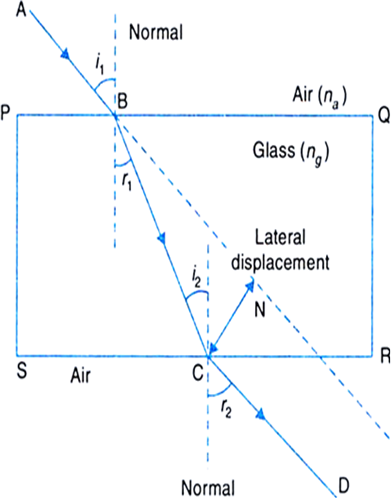Discuss the refraction through a rectangular glass slab and show that the emergent ray is parallel to the incident ray but laterally displaced. How does lateral displacement depend on the thickness of the glass slab?
Or
With the help of a ray diagram, show that when light falls obliquely on a side of rectangular slab, the emergent ray is parallel to the incident ray.
Show the lateral displacement of the ray on the diagram.
Refraction through a rectangular glass slab: Consider a rectangular glass slab PQRS, as shown in Fig. A ray AB is incident on the face PQ at an angle of incidence i1. On entering the glass slab, it bends towards the normal and travels along BC at an angle of refraction r1. The refracted ray BC is incident on the face SR at an angle of incidence i2. The emergent ray CD bends away from the normal at an angle of refraction r2.
Using Snell’s law for refraction from air to glass at face PQ,![]() ....(1)
....(1)
Fig. Refraction through a glass slab Using Snell’s law for refraction from glass to air at face SR,
![]()
But ![]() therefore
therefore
![]() ...(2)
...(2)
Multiplying equations (1) and (2), we get
![]()
or ![]()
Thus, the emergent ray CD is parallel to the incident ray AB, but it has been laterally displaced by a perpendicular distance CN with respect to the incident ray. This lateral shift in the path of light on emerging from a medium with parallel faces is called lateral displacement.
It is found that the lateral displacement is directly proportional to the thickness of the glass slab.
